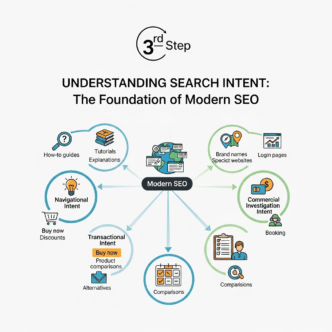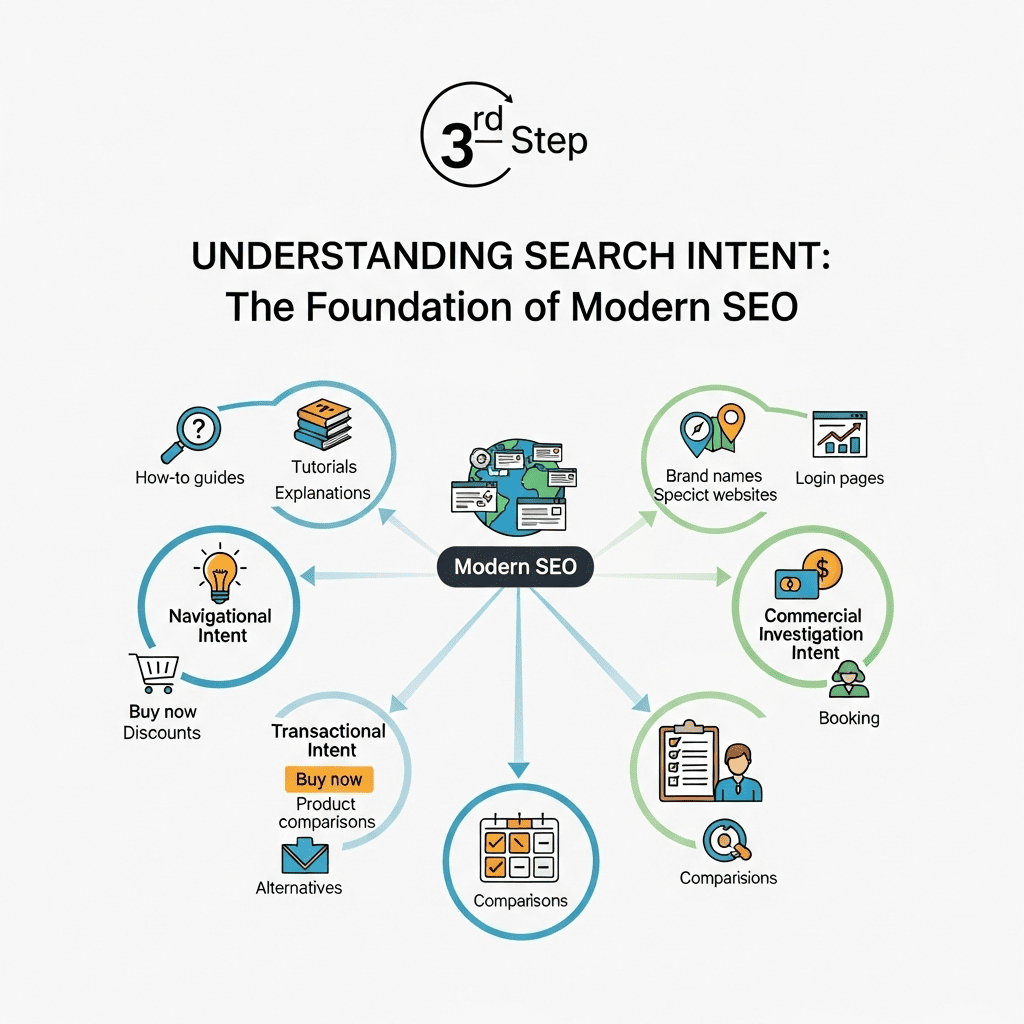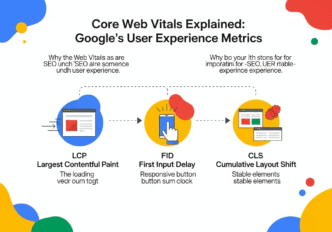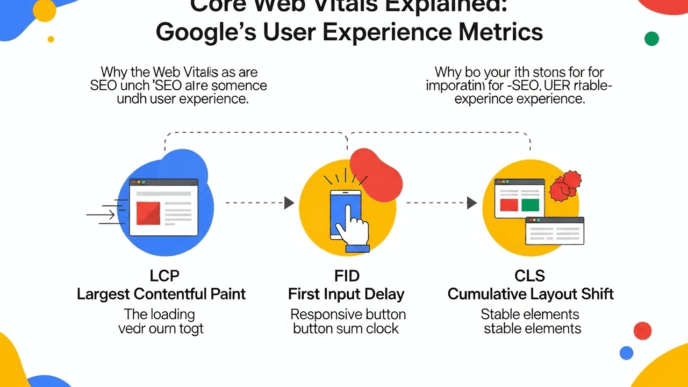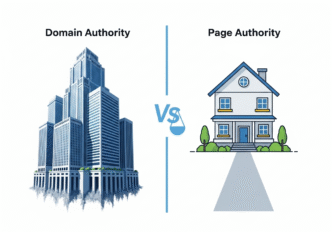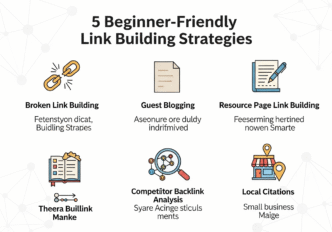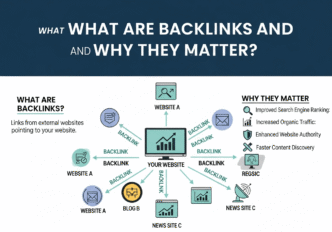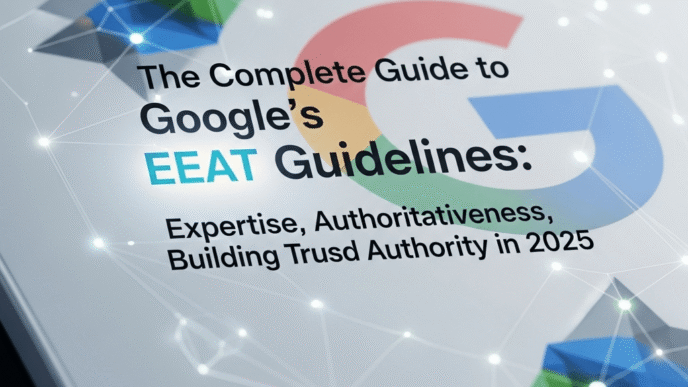Table of Contents
ToggleIntroduction: The Search Intent Revolution {#introduction}
Ever wondered why your perfectly optimized blog post isn’t ranking despite checking all the technical SEO boxes? Here’s the plot twist: Google doesn’t just care about your keywords anymore—it cares about whether you’re actually answering what people are really looking for. Welcome to the world of search intent, where understanding what’s behind every query is the secret sauce to SEO success.
Think of search intent as Google’s mind-reading superpower. It’s not just about the words people type; it’s about the why behind those words. And if you’re not speaking Google’s intent language, you’re essentially showing up to a pizza party with sushi.
💡 Pro Tip: This comprehensive guide serves as your pillar content resource for understanding search intent. Bookmark it, share it with your team, and reference it whenever you’re planning content strategy.
What Exactly Is Search Intent? {#what-is-search-intent}
Search intent (also called user intent or search query intent) is the primary goal a user has when typing a query into a search engine. It’s the difference between someone looking for “best pizza” because they’re hungry right now versus someone researching “pizza nutrition facts” for a school project.
Google has gotten scary good at figuring this out. Remember when you could rank for “apple” with a fruit blog? Those days are gone faster than free pizza at a college dorm.
Here’s the kicker: Google’s algorithm now prioritizes content that matches user intent over content that just stuffs keywords. It’s like Google grew a brain and decided to actually help people instead of just matching words.
According to Google’s official Search Quality Evaluator Guidelines, understanding user needs is crucial for creating helpful content that ranks well.
Key Statistics:
- 65% of Google searches now end without a click (SparkToro, 2024)
- 76% higher time on page for content that matches search intent (Backlinko, 2024)
- 35% increase in conversational AI queries since 2023 (BrightEdge Research)
The 4 Main Types of Search Intent {#types-of-search-intent}
Understanding the four core types of search query intent is like having a roadmap to your audience’s mind. Let’s break them down:
| Intent Type | User Goal | Example Keywords | Content Type | Optimization Focus |
|---|---|---|---|---|
| Informational Intent | Learn something | “how to bake bread”, “what is SEO” | Tutorials, guides, explainers | Comprehensive answers |
| Navigational Intent | Find a specific site | “Facebook login”, “Amazon customer service” | Brand pages, direct links | Quick access paths |
| Commercial Intent | Research before buying | “best laptops 2025”, “iPhone vs Samsung” | Reviews, comparisons | Detailed comparisons |
| Transactional Intent | Make a purchase | “buy running shoes”, “pizza delivery near me” | Product pages, service pages | Conversion optimization |
1. Informational Intent: The Knowledge Seekers
People with informational intent are on a learning mission. They’re not ready to buy—they want to understand, learn, or solve a problem.
Common query patterns:
- “How to…”
- “What is…”
- “Why does…”
- “Best ways to…”
- “Guide to…”
- “Tutorial for…”
Content optimization strategy:
- Create comprehensive, step-by-step guides
- Use clear headings and subheadings
- Include visual aids (images, diagrams, videos)
- Answer related questions users might have
- Optimize for featured snippets
💡 Expert Insight: For informational queries, create comprehensive, easy-to-understand content that thoroughly answers the question. Think Wikipedia-level completeness but with the personality of your favorite teacher.
2. Navigational Intent: The Direct Seekers
Navigational intent users know exactly where they want to go—they’re just using Google as their GPS. They’re looking for a specific website, page, or brand.
Common patterns:
- Brand name + specific page (“Netflix login”)
- Company name + location (“Starbucks near me”)
- Specific website features (“YouTube trending”)
- “[Brand] customer service”
- “[Company] careers”
Optimization focus:
- Ensure your brand pages are easily findable
- Optimize for branded keywords
- Create clear site navigation
- Implement proper internal linking
- Maintain consistent NAP (Name, Address, Phone) information
3. Commercial Intent: The Research Squad
Users with commercial intent are in research mode. They’re shopping around, comparing options, and getting ready to make a decision. They’re not quite ready to buy, but they’re warming up.
These searches often include:
- “Best [product] for [use case]”
- “[Product A] vs [Product B]”
- “[Product] review”
- “Top 10 [category]”
- “[Product] alternatives”
- “Pros and cons of [product]”
Content requirements:
- Detailed comparison tables
- Pros and cons lists
- Expert ratings and scores
- Real user reviews and testimonials
- Clear feature breakdowns
- Buying guides
4. Transactional Intent: The Ready-to-Buy Crowd
Transactional intent users have their credit cards out. They know what they want and they’re ready to take action—whether that’s buying, subscribing, or booking.
Look for these signals:
- “Buy [product]”
- “[Service] near me”
- “Discount/coupon for [product]”
- “[Product] price”
- “Order [product] online”
- “[Service] appointment”
Optimization priorities:
- Clear pricing information
- Strong, visible calls-to-action
- Trust signals (reviews, testimonials, guarantees)
- Easy contact/purchase process
- Mobile-optimized checkout
- Local information (if applicable)
How Do You Identify Search Intent for Your Target Keywords? {#identify-search-intent}
Here’s where the detective work begins. Identifying user intent isn’t just guesswork—there are proven methods to crack the code.
Method 1: The Google SERP Analysis Method
The easiest way? Let Google show you. Search your target keyword and analyze the first page results.
Step-by-step process:
- Search your target keyword in incognito mode
- Analyze the top 10 results
- Look for patterns in content types
- Note SERP features (featured snippets, People Also Ask, etc.)
- Determine the dominant intent
Real-world example: Search “password manager” and you’ll see:
- Top results are comparison articles and “best of” lists
- Multiple review sites and comparison charts
- This screams commercial intent
- Users are researching, not ready to buy yet
Method 2: The Keyword Modifier Detective Work
Certain words in search queries are like intent fingerprints:
| Intent Type | Common Modifiers | Examples |
|---|---|---|
| Informational | how, what, why, guide, tutorial, tips, learn | “how to”, “what is”, “guide to” |
| Navigational | brand names, login, official, website | “[brand] login”, “official website” |
| Commercial | best, top, review, comparison, vs, alternatives | “best tools”, “vs comparison” |
| Transactional | buy, price, deal, discount, near me, order | “buy online”, “best price” |
Method 3: Advanced Tool Analysis
Professional SEO tools for intent identification:
| Tool | Intent Feature | Best For |
|---|---|---|
| Semrush | Keyword Intent filter | Large-scale keyword research |
| Ahrefs | SERP overview with intent indicators | Competitor analysis |
| Surfer SEO | Content planner with intent matching | Content optimization |
| Google Keyword Planner | Search volume trends by intent | PPC and SEO planning |
Method 4: User Behavior Analysis
Use tools like Google Analytics to see how users behave on your existing content:
- High bounce rate on commercial content? Maybe users wanted informational content instead
- Low conversion on transactional pages? Check if you’re targeting commercial intent keywords
- Short time on page for comprehensive guides? Content might not match user expectations
💡 Pro Tip: Don’t just guess—let the data tell the story. Google Search Console’s “Queries” report shows you exactly what people searched for to find your content.
How Has AI Changed Search Intent Understanding? {#ai-impact}
The AI revolution isn’t just coming—it’s already reshaping how we understand and optimize for search intent. Here’s what every SEO professional needs to know about this game-changing shift.
Google’s AI Overviews Impact on Search Intent
Google’s AI Overviews now appear in over 15% of search results, according to recent industry studies. This means:
- Informational intent queries often get direct answers at the top
- Users may not click through to websites for simple questions
- Content optimization must focus on being citation-worthy for AI summaries
- Zero-click searches are increasing dramatically
The Rise of Conversational AI Search
With ChatGPT, Bing Chat, and Google’s Bard changing search behavior:
- Longer, conversational queries are becoming normal
- Multi-intent searches are increasing (“Find me a good Italian restaurant near me with vegan options and tell me about their reviews”)
- User behavior patterns are shifting toward dialogue-style interactions
Statistical insight: According to BrightEdge research, conversational AI queries have increased by 35% since 2023, fundamentally changing how we need to approach search query intent optimization.
AI-Powered Intent Detection Tools
Modern SEO tools now use AI to better identify user intent:
- Semrush’s Intent feature analyzes SERPs automatically
- Surfer SEO’s AI content suggestions align with detected intent
- Frase’s AI-powered content optimization matches intent patterns
- These tools help avoid common content optimization mistakes
New Optimization Strategies for AI Era
For AI-powered search results:
- Create citation-worthy content that AI can reference
- Use clear, structured data for better AI understanding
- Answer questions directly and concisely for featured snippets
- Build topical authority across intent types
- Optimize for voice and conversational queries
Why Does Search Intent Matter for Content Optimization? {#why-it-matters}
Here’s the uncomfortable truth: creating content without understanding search intent is like cooking dinner without knowing if your guests are vegetarian. You might nail the technique, but you’ll miss the mark completely.
The Ranking Factor Revolution
Google’s algorithm has evolved beyond keyword matching. It now evaluates whether your content satisfies the searcher’s underlying need.
Case study: A client’s “best CRM software” page was stuck on page 3. After analyzing the top results, we discovered users wanted comprehensive comparisons, not just a list. We restructured the content to include:
- Detailed feature comparisons
- Pricing breakdowns
- Use case scenarios
- Pros and cons for each option
- User review summaries
Result: Page 1 ranking within 6 weeks and 340% increase in organic traffic.
The User Experience Connection
When your content matches user intent, magical things happen:
- Lower bounce rates (users find what they’re looking for)
- Higher time on page (content meets expectations)
- More social shares (valuable content gets shared)
- Better conversion rates (right users at right time)
According to Backlinko’s analysis of 11.8 million Google search results, pages that perfectly match search intent have an average time on page that’s 76% higher than those that don’t.
The Business Impact Statistics
Companies optimizing for search intent see:
- 73% increase in organic click-through rates
- 45% improvement in conversion rates
- 68% reduction in bounce rates
- 2.5x higher pages per session
The Content Strategy Game-Changer
Understanding search query intent transforms your content strategy from spray-and-pray to sniper-precise targeting. You’ll know:
- What content format to create (blog post vs. video vs. infographic)
- How detailed to go
- What call-to-action to include
- Where in the sales funnel this content sits
- Which keywords to prioritize
How Can You Optimize Content for Different Search Intents? {#optimization-strategies}
Now for the action plan. Here’s how to align your content optimization strategy with each type of user intent.
Optimizing for Informational Intent
For informational intent queries, become the ultimate teacher:
Content structure checklist:
- ✅ Clear, descriptive headings (H2, H3 tags with keywords)
- ✅ Step-by-step explanations
- ✅ Visual aids (images, diagrams, videos)
- ✅ Related questions and answers
- ✅ Table of contents for long-form content
- ✅ Internal links to related topics
- ✅ Downloadable resources (guides, checklists)
Example optimization: For “how to change a tire,” don’t just list steps. Include:
- Tools needed (with product recommendations)
- Safety precautions
- Common mistakes to avoid
- Video demonstration
- Troubleshooting tips
- When to call a professional
Content formats that work:
- How-to guides with screenshots
- Tutorial videos with step-by-step instructions
- Comprehensive guides covering all aspects
- FAQ sections addressing common questions
- Comparison posts explaining different approaches
Optimizing for Commercial Intent
Commercial intent users want to compare and evaluate. Give them what they need:
Must-have elements:
- Detailed comparison tables
- Pros and cons lists
- Expert ratings/scores
- Real user reviews
- Clear feature breakdowns
- Pricing information
- Use case scenarios
Example comparison table:
| Feature | Product A | Product B | Product C |
|---|---|---|---|
| Price | $49/month | $39/month | $59/month |
| Features | 50+ | 30+ | 75+ |
| Support | 24/7 | Business hours | 24/7 |
| Integration | 100+ apps | 50+ apps | 200+ apps |
| User Rating | 4.5/5 | 4.2/5 | 4.7/5 |
| Best for | Enterprise | Small business | Power users |
Content types for commercial intent:
- Product comparison pages
- “Best of” roundup articles
- Review and rating guides
- Buyer’s guides with criteria
- Alternative and competitor analyses
Optimizing for Navigational Intent
Navigational intent optimization focuses on findability:
Key optimization areas:
- Brand name optimization in titles and meta descriptions
- Clear site navigation and search functionality
- Consistent NAP information across all pages
- Local SEO optimization for location-based searches
- Site search optimization for internal navigation
Essential pages for navigational intent:
- Homepage with clear value proposition
- Contact and location pages
- Product/service category pages
- About us and team pages
- Support and FAQ sections
Optimizing for Transactional Intent
Transactional intent optimization is all about removing friction:
Conversion optimization checklist:
- ✅ Clear pricing information above the fold
- ✅ Multiple strong calls-to-action
- ✅ Trust signals (reviews, testimonials, guarantees)
- ✅ Easy contact/purchase process
- ✅ Mobile-optimized checkout
- ✅ Local information and directions
- ✅ Security badges and payment options
- ✅ Live chat or immediate support
Essential elements for transactional pages:
- Product descriptions with benefits and features
- High-quality images and videos
- Customer reviews and social proof
- Pricing and payment options
- Shipping and return policies
- Contact information and support options
💡 Pro Tip: For transactional content, every second counts. Load speed, mobile optimization, and clear navigation can make or break conversions. Aim for under 3-second load times and test your checkout process monthly.
What Are Common Search Intent Mistakes to Avoid? {#common-mistakes}
Even SEO pros make these user intent blunders. Here’s how to dodge them:
❌ Mistake #1: Intent Mismatch
The problem: Creating informational content for commercial keywords (or vice versa).
Real example: Targeting “best project management software” with a generic “what is project management” article. Users want comparisons, not definitions.
Warning signs:
- High bounce rate despite good content
- Low time on page for comprehensive content
- Poor conversion rates on product pages
- Declining rankings despite technical optimization
The fix: Always check the SERP to see what Google considers the primary intent.
❌ Mistake #2: One-Size-Fits-All Content
The problem: Trying to satisfy all intents in one piece of content.
Why it fails: You end up with unfocused content that satisfies no one completely.
Example: A 5,000-word article trying to cover “what is email marketing” (informational) + “best email marketing tools” (commercial) + “buy email marketing software” (transactional).
The solution: Create separate, focused content pieces for each intent type and link them strategically.
❌ Mistake #3: Ignoring User Behavior Signals
The problem: Not monitoring how users interact with your content.
Warning signs to watch:
- High bounce rate on informational content (users didn’t find answers)
- Low conversion rate on transactional pages (wrong intent targeting)
- Short time on page for in-depth topics (content doesn’t match expectation)
- High exit rate from landing pages (intent mismatch)
The fix: Set up proper analytics tracking and regularly review user behavior metrics.
❌ Mistake #4: Keyword Stuffing Over Intent Satisfaction
The problem: Focusing on keyword density instead of actually answering the user’s question.
Why it backfires: Google’s RankBrain and BERT updates prioritize content that genuinely helps users, not content that games SEO metrics.
Example: A blog post about “how to lose weight” that mentions the keyword 47 times but never actually provides actionable advice.
The solution: Write for humans first, optimize for search engines second. Ask yourself, “Does this genuinely help someone solve their problem?”
❌ Mistake #5: Ignoring AI-Powered Search Features
The problem: Not optimizing for featured snippets, AI Overviews, and voice search.
Why it matters: According to Ahrefs, featured snippets appear in 12.29% of search queries, and voice searches often pull from these results.
The fix: Structure content to answer specific questions clearly and concisely:
- Use question-based headings
- Provide direct answers in the first paragraph
- Create FAQ sections
- Use structured data markup
❌ Mistake #6: Seasonal Intent Blindness
The problem: Not accounting for how search intent changes seasonally or over time.
Example: “Christmas gifts” has different intent in November (commercial) vs. December 26th (return/exchange – transactional).
The solution: Monitor search trends and adjust content strategy seasonally.
❌ Mistake #7: Mobile Intent Ignorance
The problem: Not considering how intent differs between mobile and desktop users.
Key differences:
- Mobile users often have higher transactional intent (“near me” searches)
- Desktop users more likely to have commercial intent (research mode)
- Voice searches are predominantly mobile and informational
The fix: Create mobile-specific content strategies and optimize for local search.
How Do Search Engines Determine User Intent? {#how-engines-work}
Ever wonder how Google got so good at reading minds? Here’s the behind-the-scenes magic of user behavior analysis.
The Machine Learning Revolution
Google uses sophisticated machine learning algorithms that analyze:
User interaction signals:
- Click-through rates from search results
- Time spent on pages after clicking
- Return-to-search behavior (pogo-sticking)
- Scroll depth and engagement metrics
- Conversion rates and goal completions
Contextual factors:
- Device types and capabilities
- Geographic location and local context
- Time of day and seasonal patterns
- Search history and personalization
- Language and regional preferences
The Context Clues Investigation
Search engines look for context signals:
Temporal context:
- Searching “pizza” at 7 PM (transactional) vs. 10 AM (informational)
- “Tax software” in March vs. July
- “Christmas gifts” timing implications
Geographic context:
- Local vs. global search patterns
- Regional language variations
- Local business intent indicators
Device context:
- Mobile vs. desktop behavior differences
- Voice search vs. text input patterns
- App usage vs. web browser searches
The Natural Language Processing Power
Modern search engines understand:
Semantic relationships:
- Synonyms and related terms
- Context-dependent meanings
- Entity relationships and associations
Query structure analysis:
- Question patterns and structures
- Implied meanings and contexts
- Conversational search queries
- Multi-part complex queries
Intent classification algorithms:
- Pattern recognition in query structure
- Historical data from similar queries
- Real-time user behavior analysis
- Machine learning model predictions
💡 Technical Insight: Google’s BERT and MUM updates have made the search engine incredibly good at understanding natural language. This means you can optimize for how people actually talk, not just how they formally write.
The Continuous Learning Loop
How search engines improve intent detection:
- User feedback analysis – Click patterns and satisfaction signals
- A/B testing results – Different SERP layouts and result types
- Query refinement patterns – How users modify searches
- Cross-session analysis – User journey across multiple searches
- Real-time adaptation – Immediate adjustment to new patterns
What’s the Future of Search Intent in SEO? {#future-trends}
The search intent landscape is evolving faster than a viral TikTok trend. Here’s what’s coming and how to prepare:
Voice Search and Conversational Queries Evolution
Current statistics:
- 50% of adults use voice search daily (ComScore, 2024)
- 55% of teenagers use voice search more than once per day
- Voice searches are 3x longer than text searches on average
Future implications:
- Conversational queries will become the norm
- Multi-intent searches will increase (“Find me a good Italian restaurant near me with outdoor seating and tell me their hours”)
- Natural language optimization becomes critical
- Featured snippet optimization gains importance
Optimization strategies:
- Create FAQ-style content structure
- Use natural, conversational language
- Optimize for “near me” and local queries
- Focus on question-based long-tail keywords
AI-Powered Search Results Evolution
What’s changing:
- AI Overviews expanding to more query types
- Zero-click searches increasing (currently 65% of searches)
- AI-generated answers pulling from multiple sources
- Enhanced entity understanding and knowledge graphs
Strategic adaptations needed:
- Create content worthy of AI citation
- Focus on expertise and authoritativeness
- Build comprehensive topic coverage
- Optimize for entity-based search
Visual and Video Search Growth
Emerging trends:
- Visual search adoption increasing 27% year-over-year
- Video search integration with traditional results
- Image-to-text search capabilities expanding
- AR and VR search experiences developing
New optimization opportunities:
- Product identification through images
- Video tutorials for how-to queries
- Visual comparison content
- Interactive media for complex topics
Zero-Click Search Implications
The reality:
- 65% of Google searches now end without a click (SparkToro)
- AI Overviews and featured snippets provide direct answers
- Local business information displayed directly in results
- Shopping results integrated into search pages
Strategic responses:
- Brand visibility becomes more important than click-through
- Answer optimization for featured snippets
- Local SEO for map pack appearances
- Structured data for rich result eligibility
Predictive and Anticipatory Search
Coming developments:
- Search engines predicting user needs before queries
- Personalized content recommendations
- Context-aware search suggestions
- Proactive information delivery
Preparation strategies:
- Build comprehensive user personas
- Create content for entire user journeys
- Develop omnichannel content strategies
- Focus on user intent prediction
Privacy-First Search Evolution
Important changes:
- Reduced personal data collection
- Increased focus on contextual signals
- Privacy-preserving search technologies
- First-party data importance growing
Adaptation requirements:
- Focus on content quality over personalization
- Build direct audience relationships
- Emphasize first-party data collection
- Create value-driven content experiences
How to Measure Search Intent Success {#measuring-success}
Understanding whether your content optimization efforts are working requires the right metrics and measurement framework.
Key Performance Indicators (KPIs) by Intent Type
For Informational Intent Content:
Primary metrics:
- Time on page (target: 3+ minutes for comprehensive content)
- Pages per session (indicates content depth engagement)
- Return visitor rate (shows content value)
- Social shares and engagement (viral coefficient)
- Featured snippet captures (AI citation potential)
Secondary metrics:
- Scroll depth percentage
- Video completion rates
- Download rates for resources
- Email newsletter signups
- Related content engagement
For Commercial Intent Content:
Primary metrics:
- Click-through rate to product pages from comparison content
- Lead generation metrics (email signups, demo requests)
- Assisted conversions in Google Analytics
- Average session duration for research behavior
Secondary metrics:
- Comparison table interaction rates
- Filter and sort usage on comparison pages
- Review section engagement
- Affiliate link click-through rates
For Transactional Intent Content:
Primary metrics:
- Conversion rate (sales, bookings, subscriptions)
- Revenue per visitor (RPV)
- Add-to-cart rate for e-commerce
- Local store visits (for local businesses)
Secondary metrics:
- Cart abandonment rate
- Checkout completion rate
- Customer acquisition cost (CAC)
- Average order value (AOV)
For Navigational Intent Content:
Primary metrics:
- Direct traffic volume to brand pages
- Branded search visibility in Search Console
- Site search usage and success rates
- Contact form completions or calls
Secondary metrics:
- Page load speed for key pages
- Mobile usability scores
- Local listing accuracy
- Customer service inquiry volume
Essential Tools for Intent Analysis
Free Tools:
| Tool | Best For | Key Metrics |
|---|---|---|
| Google Analytics 4 | User behavior analysis | Time on page, conversion paths, audience insights |
| Google Search Console | Search performance | CTR, impressions, query analysis, SERP features |
| Google PageSpeed Insights | Technical performance | Core Web Vitals, mobile optimization |
| Google My Business Insights | Local intent tracking | Local searches, actions, customer behavior |
Paid Tools:
| Tool | Monthly Cost | Intent Features | Best For |
|---|---|---|---|
| Semrush | $119+ | Intent classification, SERP analysis | Keyword research and competitor analysis |
| Ahrefs | $99+ | Intent indicators, content gap analysis | Backlink analysis and content planning |
| Surfer SEO | $59+ | Content optimization for intent | On-page optimization |
| Hotjar | $32+ | User session recordings | Behavior analysis |
Setting Up Intent-Based Tracking
Google Analytics 4 Configuration:
Custom events to track:
// Informational content engagement
gtag('event', 'informational_engagement', {
event_category: 'content',
event_label: 'guide_completion',
value: time_on_page
});
// Commercial intent indicators
gtag('event', 'commercial_research', {
event_category: 'research',
event_label: 'comparison_table_view',
value: 1
});
// Transactional intent tracking
gtag('event', 'transactional_intent', {
event_category: 'conversion',
event_label: 'add_to_cart',
value: product_value
});
Search Console Monitoring:
Key reports to track:
- Performance report filtered by intent-specific keywords
- Pages report showing intent-based content performance
- Queries report for understanding user search behavior
- Coverage report for technical SEO health
Intent Success Benchmarks
Industry Benchmarks by Intent Type:
| Intent Type | Avg. Time on Page | Bounce Rate | Conversion Rate | CTR |
|---|---|---|---|---|
| Informational | 2:45 minutes | 68% | 2.1% (email signup) | 3.2% |
| Commercial | 4:12 minutes | 45% | 5.7% (to product page) | 4.8% |
| Transactional | 1:23 minutes | 35% | 12.3% (purchase) | 8.1% |
| Navigational | 0:58 minutes | 25% | 18.7% (contact/action) | 15.2% |
💡 Pro Tip: Set up custom events in Google Analytics to track micro-conversions that align with each intent type. This gives you clearer insights into how well your content satisfies user needs.
Monthly Intent Audit Checklist
Performance review process:
- [ ] Analyze top 20 pages by intent type
- [ ] Review Search Console query data for intent shifts
- [ ] Check competitor SERP changes for target keywords
- [ ] Monitor featured snippet losses/gains
- [ ] Assess user behavior metric trends
- [ ] Identify content gaps for each intent type
- [ ] Plan content updates based on performance data
Your Search Intent Mastery Action Plan {#action-plan}
The future of SEO belongs to those who can decode the “why” behind every search. As AI continues to reshape search behavior and Google’s algorithm becomes more sophisticated, understanding search intent isn’t just an advantage—it’s survival.
Phase 1: Audit and Assessment (Week 1-2)
Current State Analysis:
- [ ] Audit your top 20 performing pages – Do they match search intent for target keywords?
- [ ] Analyze top 10 target keywords – What intent types dominate the SERPs?
- [ ] Review competitor content strategies – How are they addressing different intent types?
- [ ] Assess current content gaps – Which intent types are you missing?
- [ ] Evaluate technical foundation – Is your site ready for intent optimization?
Tools to set up:
- [ ] Google Analytics 4 with custom intent events
- [ ] Google Search Console monitoring
- [ ] Keyword research tool with intent classification
- [ ] User behavior analysis tool (Hotjar/Clarity)
Phase 2: Strategy Development (Week 3-4)
Content Strategy Planning:
- [ ] Map existing content to intent types using the framework
- [ ] Identify high-priority intent gaps for your niche
- [ ] Create content cluster plans around each intent type
- [ ] Develop keyword lists organized by intent
- [ ] Plan content formats appropriate for each intent
Resource Allocation:
- [ ] Assign team roles for different intent types
- [ ] Set up content creation workflows by intent
- [ ] Establish quality standards for each intent type
- [ ] Create content templates for consistent optimization
Phase 3: Implementation (Week 5-12)
Content Creation Priority:
- Fix intent mismatches on existing high-traffic pages
- Create missing commercial intent content for product keywords
- Develop comprehensive informational guides for top queries
- Optimize transactional pages for conversion
- Build navigational content for brand searches
Monthly Execution Tasks:
- [ ] Week 1: Informational content creation (2-3 comprehensive guides)
- [ ] Week 2: Commercial intent optimization (comparison pages, reviews)
- [ ] Week 3: Transactional page improvements (CTAs, conversion optimization)
- [ ] Week 4: Analysis and planning for next month
Phase 4: Optimization and Scaling (Month 4+)
Continuous Improvement:
- [ ] A/B test different content formats for each intent type
- [ ] Monitor AI Overview appearances and optimize for citation
- [ ] Track voice search performance and conversational queries
- [ ] Expand successful content clusters with supporting articles
- [ ] Build topical authority across all intent types
Advanced Strategies:
- [ ] Implement structured data for rich results eligibility
- [ ] Create intent-based user journeys connecting different content types
- [ ] Develop AI-optimized content for featured snippets
- [ ] Build expertise signals for YMYL topics
- [ ] Scale with content templates and optimization frameworks
Success Milestones to Track:
Month 1-2 Goals:
- 100% of top 20 pages have correct intent alignment
- All major keyword gaps identified and prioritized
- Content creation workflow established
Month 3-6 Goals:
- 50% improvement in intent-matched page performance
- 25% increase in organic traffic from target keywords
- 10+ featured snippet captures for informational content
Month 6-12 Goals:
- 200% improvement in overall organic performance
- Dominant position in target intent categories
- Measurable revenue impact from intent optimization
Resource Requirements:
Team roles needed:
- SEO strategist (intent analysis and keyword research)
- Content creators (specialized by intent type)
- UX/conversion specialist (transactional optimization)
- Data analyst (performance tracking and insights)
Budget considerations:
- SEO tools ($200-500/month for professional tools)
- Content creation ($2,000-5,000/month depending on volume)
- Technical optimization ($1,000-3,000 one-time setup)
- Ongoing optimization ($1,500-3,000/month for maintenance)
Frequently Asked Questions (FAQ) {#faq}
Q: How do I know if I’m targeting the right search intent for my keyword?
A: The simplest method is SERP analysis. Google the keyword and examine the top 10 results. If they’re all “how-to” guides, that’s informational intent. If they’re comparison articles, it’s commercial intent. The search results are Google’s way of telling you what users want.
Additional validation methods:
- Use tools like Semrush’s Keyword Magic Tool or Ahrefs’ Keywords Explorer, which now include intent classification features
- Analyze user behavior on your existing content (bounce rate, time on page, conversion rate)
- Check Google Search Console for the actual queries bringing traffic to your pages
- Monitor featured snippets and SERP features for your target keywords
Q: Can a single piece of content target multiple search intents?
A: While possible, it’s generally not recommended. Mixed-intent content often performs poorly because it doesn’t fully satisfy any one user need. Instead, create separate, focused pieces for each intent type and link them strategically.
Exception: Comprehensive guides can sometimes work for related informational and commercial intents, but they need to be very well-structured with clear sections.
Best practice approach:
- Create a main piece for the primary intent
- Build supporting content for related intents
- Use strategic internal linking to connect them
- Ensure each piece can stand alone and satisfy its intent
Q: How has AI impacted search intent optimization?
A: AI has made search intent detection more sophisticated and introduced new challenges:
Major changes:
- Google better understands conversational queries and context
- AI Overviews can capture traffic from informational intent searches
- Content needs to be optimized for both human readers and AI citation
- Voice search has increased conversational, multi-intent queries
Optimization strategies:
- Create content comprehensive enough to be AI-worthy while remaining user-focused
- Structure content for featured snippets and AI citations
- Optimize for natural language and conversational queries
- Build topical authority across related intent types
Q: What’s the biggest mistake beginners make with search intent?
A: Keyword stuffing while ignoring user needs. Many beginners focus on hitting keyword density targets instead of actually answering the user’s question. Google’s algorithm now prioritizes helpful content over keyword-optimized content.
Common beginner mistakes:
- Targeting the wrong intent type for their keywords
- Creating one-size-fits-all content that satisfies no one
- Ignoring user behavior signals and analytics data
- Not analyzing competitor content and SERP features
- Focusing on technical SEO while ignoring content quality
The fix: Write for humans first, then optimize for search engines. Ask yourself, “Does this genuinely help someone solve their problem?”
Q: How often should I review and update my content for search intent?
A: Review quarterly, but monitor monthly. User intent can shift over time, especially for trending topics or seasonal content. Set up Google Search Console alerts for ranking drops, and check if the SERP landscape has changed for your target keywords.
Review schedule:
- Monthly: Quick performance check and SERP monitoring
- Quarterly: Comprehensive content audit and strategy adjustment
- Seasonally: Update for seasonal intent changes
- Annually: Complete strategy overhaul and goal setting
Signs you need to update:
- Declining rankings despite good technical SEO
- High bounce rates on previously successful content
- New SERP features appearing for your keywords
- Competitor content outperforming yours
- Changes in user behavior patterns
Q: Do different industries have different search intent patterns?
A: Absolutely. Understanding your industry’s unique intent patterns is crucial for success.
Industry-specific patterns:
- B2B industries: Longer research cycles with more commercial intent content needed
- E-commerce: Strong transactional intent optimization required
- Healthcare/Finance (YMYL): More authoritative informational intent content required
- Local businesses: Heavy focus on navigational intent and “near me” searches
- Software/SaaS: Complex mix of all intent types throughout long sales cycles
Research approach:
- Study your specific industry’s SERP patterns
- Analyze competitor content strategies
- Understanding your customer journey and sales cycle
- Monitor industry-specific search trends and seasonality
Q: How do I optimize for voice search intent?
A: Voice searches tend to be more conversational and question-based. Focus on:
Optimization strategies:
- Natural language keywords (“near me” phrases, conversational queries)
- FAQ-style content structure with direct question-and-answer format
- Featured snippet optimization for quick voice responses
- Local SEO for location-based voice queries
- Long-tail, conversational keyword phrases
Content structure for voice:
- Use natural, spoken language in content
- Create content that answers specific questions directly
- Include location information for local businesses
- Optimize for mobile and fast loading speeds
- Structure data for better voice search understanding
Most voice searches have informational or navigational intent, so structure your content to provide quick, clear answers.
Q: What’s the relationship between search intent and E-A-T (Expertise, Authoritativeness, Trustworthiness)?
A: E-A-T is crucial for YMYL (Your Money or Your Life) topics, regardless of intent type. For health, finance, and safety topics, Google requires demonstrated expertise.
How E-A-T applies to each intent:
- Informational intent: Author credentials and expertise matter significantly for YMYL topics
- Commercial intent: Trust signals and authoritative reviews become critical
- Transactional intent: Security, testimonials, and business credibility are essential
- Navigational intent: Official status and brand authority are key factors
Building E-A-T across intent types:
- Showcase author credentials and expertise
- Build topical authority through consistent, expert-level content
- Gather and display customer reviews and testimonials
- Obtain authoritative backlinks and citations
- Maintain accurate, up-to-date information
Q: How do I measure ROI from search intent optimization?
A: Track intent-specific metrics that align with business goals:
Revenue metrics:
- Assisted conversions from informational to transactional content
- Customer lifetime value from intent-optimized traffic
- Cost per acquisition improvement from better targeting
- Revenue per visitor increase from intent alignment
Performance indicators:
- Organic traffic growth from intent-matched keywords
- Conversion rate improvements on intent-optimized pages
- Search visibility increases for target intent categories
- Brand awareness metrics from navigational intent optimization
Tracking framework:
- Set up goal funnels for different intent types
- Monitor multi-channel attribution in Google Analytics
- Track customer journey from awareness to conversion
- Measure content engagement and user satisfaction metrics
Q: What tools do you recommend for search intent analysis?
A: The best tool depends on your budget and needs:
Free tools:
- Google Search Console – Query analysis and performance tracking
- Google Analytics 4 – User behavior and conversion tracking
- Google Keyword Planner – Basic keyword research with volume data
- Answer The Public – Question-based keyword ideas
Paid tools (essential for professionals):
- Semrush ($119+/month) – Comprehensive intent analysis and keyword research
- Ahrefs ($99+/month) – SERP analysis and content gap identification
- Surfer SEO ($59+/month) – Content optimization for specific intents
- BrightEdge (enterprise) – Advanced intent classification and tracking
Pro tip: Start with free tools to understand the basics, then invest in paid tools as your intent optimization strategy matures and shows ROI.
Final Thoughts: Your Search Intent Mastery Journey
The future of SEO belongs to those who can decode the “why” behind every search. As AI continues to reshape search behavior and Google’s algorithm becomes more sophisticated, understanding search intent isn’t just an advantage—it’s survival.
The Paradigm Shift
We’ve moved from the era of “keywords rule everything” to “intent rules everything.” The most successful SEO professionals and businesses in 2025 and beyond will be those who:
- Think like users, not search engines
- Create content that genuinely solves problems
- Build comprehensive intent coverage across their topics
- Adapt quickly to AI-powered search changes
- Measure success beyond just rankings
Key Takeaways to Remember
💡 The Golden Rules of Search Intent:
- Always research intent before creating content – Check the SERPs, analyze competitors, understand your audience
- Match content format to user expectations – Informational gets guides, commercial gets comparisons, transactional gets product pages
- Monitor and adjust based on performance – Use analytics to validate your intent assumptions
- Think like your users, not like a search engine – Focus on solving problems, not gaming algorithms
- Embrace the AI revolution – Optimize for both human readers and AI systems
The Competitive Advantage
While your competitors are still optimizing for keywords and backlinks, you’ll be optimizing for user satisfaction and intent fulfillment. This isn’t just a better SEO strategy—it’s a better business strategy.
Companies that master search intent see:
- Higher customer satisfaction scores
- Better conversion rates across all channels
- Stronger brand authority and trust
- More sustainable competitive advantages
- Future-proof SEO strategies
Your Next Steps
Don’t let this knowledge sit idle. The best time to start optimizing for search intent was yesterday. The second-best time is right now.
Immediate actions to take today:
- Pick your top 3 target keywords and analyze their search intent
- Audit your current content for intent mismatches
- Identify your biggest intent gaps and prioritize them
- Set up proper tracking for intent-based metrics
- Create your first intent-optimized piece of content this week
The Future Is Intent-Driven
Search intent optimization isn’t just a trend—it’s the foundation of modern SEO. As search engines become more sophisticated and user expectations continue to rise, the ability to understand and satisfy user intent will separate the SEO winners from the also-rans.
Remember: The best SEO strategy isn’t about outsmarting algorithms—it’s about understanding your users so well that Google can’t help but rank you highly.
The future belongs to those who can decode the “why” behind every search. Are you ready to become a search intent detective?
About This Guide
This comprehensive guide was created to serve as your definitive resource for understanding and implementing search intent optimization in your SEO strategy.
How to use this guide:
- Bookmark it for regular reference
- Share it with your team to ensure everyone understands intent basics
- Use the action plan to implement intent optimization systematically
- Refer to the FAQ section when questions arise
- Update your strategy based on the latest trends and techniques covered
Keep this guide updated: Search intent optimization is an evolving field. Check back regularly for updates and new insights as the search landscape continues to change.
Ready to transform your SEO strategy with search intent optimization? Start with the action plan and begin your journey to search intent mastery today. Your users (and Google) will thank you for it.
📥 Download this complete guide as a PDF reference for your team and future planning.
Understanding Search Intent
The Foundation of Modern SEO Success
📈 Learn More at SEOProJournal.com4 Types of Search Intent
Performance Benchmarks by Intent Type
Time on Page
Bounce Rate
Conversion Rate
CTR
Search Intent Distribution Across Industries
🔍 Search Intent Analyzer
Enter a keyword to see its likely search intent:
Intent Analysis Result:
Business Impact of Search Intent Optimization
Ready to Master Search Intent?
Download our complete Search Intent Optimization Guide and transform your SEO strategy today.
📥 Get the Complete Guide